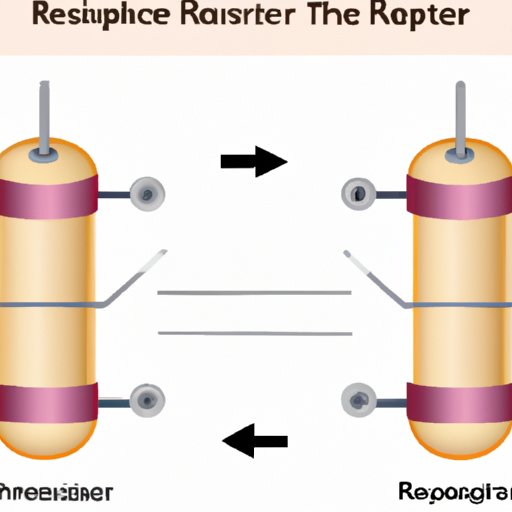Introduction
A resistor is an electronic component that is used to regulate the flow of electricity in an electronic circuit. It is one of the most important components in any electronic device and plays a key role in controlling the amount of current passing through the circuit. In this article, we will explore how resistors work, from the basics of their structure and function to the science behind their operation.
A Step-By-Step Guide to Understanding Resistor Functionality
Before delving into the specifics of how resistors work, let’s look at their basic structure and the principle of resistance. Resistors consist of two terminals, which are connected by a conductive material known as a resistor body. The conductive material can be made of various materials, including carbon, metal, or semiconductors. The resistance of the resistor depends on the material used, as well as its length and cross-sectional area.
The principle of resistance states that, when a voltage is applied across a resistor, a current is generated. This current is proportional to the voltage and inversely proportional to the resistance. In other words, the higher the voltage, the greater the current, and the higher the resistance, the lower the current. This relationship between voltage, current, and resistance is known as Ohm’s Law.

Exploring the Basics of Resistor Operation
Now that we have a basic understanding of how resistors work, let’s take a closer look at the different types of resistors and how they react to voltage and current. There are two main types of resistors – fixed resistors and variable resistors. Fixed resistors have a set resistance and are not adjustable, while variable resistors can be adjusted to change their resistance. Examples of variable resistors include potentiometers, rheostats, and thermistors.
Fixed resistors have a constant resistance regardless of the voltage or current applied, while variable resistors have a resistance that changes with the voltage or current applied. For example, a potentiometer will vary its resistance depending on the position of its knob, while a thermistor will vary its resistance depending on the temperature of its environment.
An Overview of What Makes a Resistor Tick
Now that we understand the basics of how resistors work, let’s take a look at some of the factors that affect their performance. One such factor is the material used to create the resistor. Different materials have different resistivity levels, meaning that they will produce different amounts of resistance for the same voltage and current. This means that the choice of material can have a significant impact on the performance of the resistor.
Another factor that affects the performance of a resistor is heat dissipation. When a resistor is subjected to a high current, it will generate heat due to the energy being dissipated. This heat can cause the resistor to become damaged or even destroyed if it is not adequately cooled. To prevent this, resistors are often fitted with heat sinks to help dissipate the heat.

The Science Behind How Resistors Work
Now that we have a better understanding of what goes into making a resistor and how it works, let’s take a look at the science behind its operation. As previously mentioned, Ohm’s Law states that the current flowing through a resistor is proportional to the voltage applied and inversely proportional to the resistance. This means that the higher the voltage, the greater the current, and the higher the resistance, the lower the current.
This relationship between voltage, current, and resistance can be represented using the equation V = IR, where V is the voltage, I is the current, and R is the resistance. This equation can be used to calculate the resistance of a resistor given the voltage and current, or vice versa.

A Comprehensive Look at How Resistors Perform Their Intended Function
Now that we have a good grasp of how resistors work and the science behind them, let’s take a look at how they are used in electronics circuits and other devices. Resistors are used in a variety of ways, but most commonly they are used to regulate the voltage and current in a circuit. They can also be used to reduce noise, protect components from damage, and provide precise control over the electrical signal.
Resistors are also used in amplifiers, where they act as feedback elements to control the gain of the amplifier. They are also used in digital logic circuits, where they provide a reference voltage for the logic gates. Resistors can also be found in other devices such as light dimmers, motor speed controllers, and heating elements.
Conclusion
Resistors are an essential component in any electronic circuit and play an important role in regulating the flow of electricity. In this article, we explored how resistors work, from the basics of their structure and function to the science behind their operation. We also looked at how resistors are used in electronics circuits and other devices. By understanding how resistors work, we can better appreciate their importance in the world of electronics.
(Note: Is this article not meeting your expectations? Do you have knowledge or insights to share? Unlock new opportunities and expand your reach by joining our authors team. Click Registration to join us and share your expertise with our readers.)
